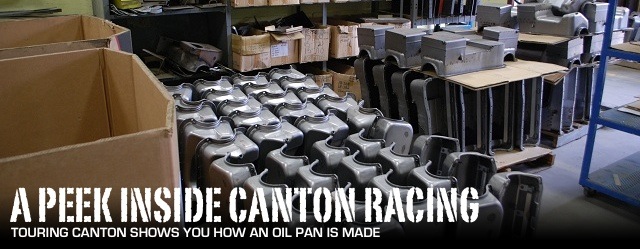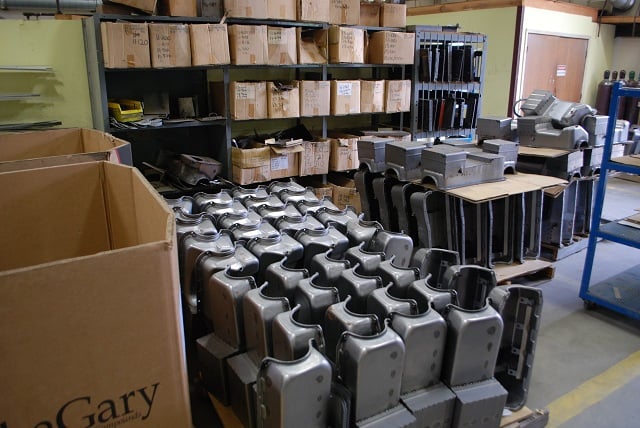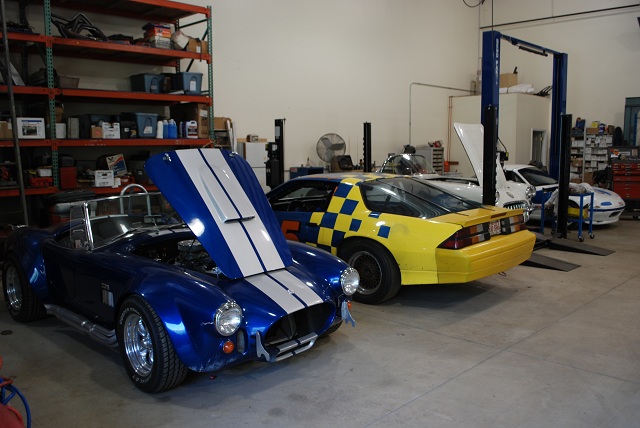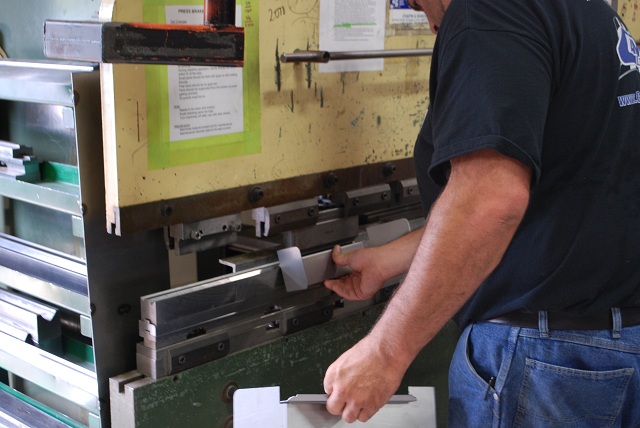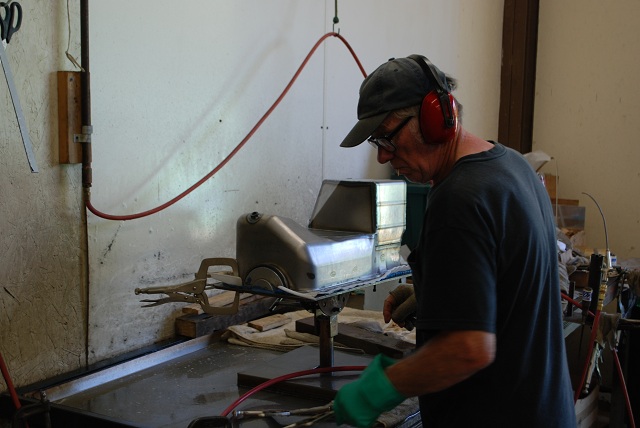Oil is the lifeblood of any engine, and it is the unheralded job of the oil pan to make sure there is a steady supply. It is a deceptively simple device, or so one might think. To find out more about how oil pans are made, we turned to Mike Zeranski Jr. of Canton Racing Products [1], based out of North Branford, Connecticut. He showed us that there is a lot more technology that goes into an oil pan than one might think.
Thirty Years And Counting: The History of Canton
Just like many other successful businesses, Canton started out in a small garage. It wasn’t until 1981 that Mike Zeranski Sr. struck out on his own. He was already well known for building custom products for a wide variety of racers. “My father started out building custom pans for circle track,” says Mike Zeranski Jr. “People knew his work from previous companies he had worked with, and they kept coming to him asking for custom oil pans.”
Soon though, the Canton product line expanded to include pans for road and drag racing as well. They also started producing other oil-related products like cooling tanks and oil accumulators. Canton has been selling their Accusump oil accumulator for over 25 years, and it is a highly regarded product in many racing circles. Today, Canton has 973 active product numbers in their catalog. “We have been able to successfully implement technology from circle track racing into road and drag racing, giving our customers the very best oil pan we can conceive,” said Zeranski Jr.
Baffled By Baffles: The Technology Behind Oil Pans
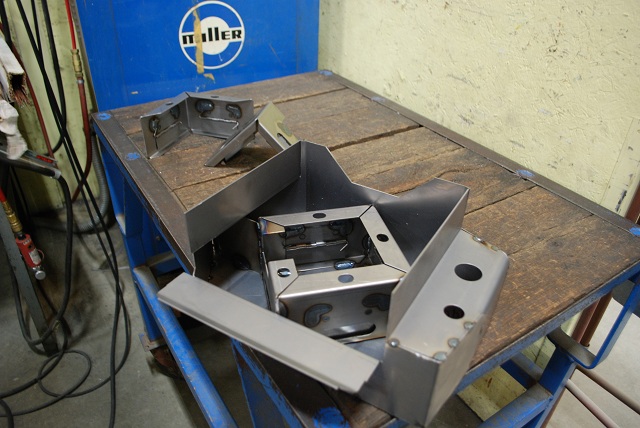 [4]
[4]These baffles and trap doors will be welded inside the pan to ensure the oil doesn't slosh away from the pump pickup
“Oil pan technology?” You might ask. “How much high-tech stuff could possibly go into a simple pan?” Believe it or not, a surprising amount, actually. Canton has a research and development team on hand that is constantly looking to improve their products based on customer needs. “As cars have gotten faster, we’ve had to make sure our oil pan technology keeps up. Specific applications, like road racing, will see the oil in the pan sloshed back and forth and side to side. It is important for these racers that there is always enough oil flowing through the engine, so we design our oil pans to make sure the oil stays where it is needed,” said Zeranski Jr.
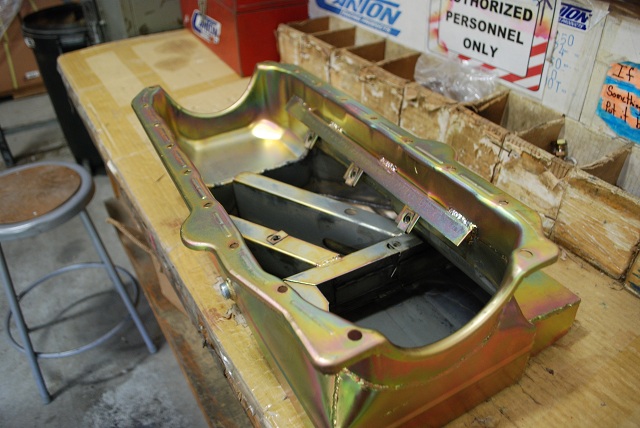 [5]
[5]Different oil pans require different baffles and trap doors, depending on if you're drag racing, road racing, and just pulling heavy stuff up a hill
Key technologies Canton Uses in its oil pans:
- Trap Door Baffle: a small door that ensures the oil pump pickup remains submerged by opening to allow oil in and closing to keep it in.
- Slosh Baffle: a partition that ensures that the oil doesn’t flow away from the pickup during hard cornering or launches.
- Oil Runner: controls the oil in the sump and directs it towards the sump.
- Windage Tray: a stamped piece of sheet metal between the block and pan that catches airborne oil and lets it drain back to the oil pan.
- Crank Scraper: a metal piece which strips excess oil – without touching the rotating assembly – reducing reciprocating drag.
 [6]
[6]Every oil pan starts out as a blank piece of sheet metal cut out to exact dimensions and punched with the appropriate holes
Canton products have always been built with racing in mind, and they offer a diverse selection of parts. So it should come as no surprise that they have a garage full of different race-ready rides. It might be one of the few places you will see a fuel-injected ’58 Corvette sitting next to a Mazda Miata and flanked by a 427 Shelby Cobra. Yet perhaps the most interesting car in the garage is Mike Zeranski Sr.’s Frankenstein 3rd generation Camaro.
Built for road racing with a full roll cage, Canton oil pan and cooling system, the Camaro was actually in a nasty wreck at Lime Rock that ruined the back half. The front of the car was still fine though, so rather than junk the car, Mike Zeranski Sr. found a rear end off another 3rd generation Camaro and welded it on. These cars sit across from an engine test stand which has an oil pan with a window equipped to it. This allows Canton’s engineers to study a new oil pan’s design and gauge how well the oil flows in any particular design.
Building An Oil Pan Out Of Blanks And Bends
To really understand the technology and design that goes into build an oil pan though, we decided to take a tour of Canton’s facilities. There we got a front row seat to seeing how a oil pan is made from beginning to end.
The process of manufacturing an oil pan starts with the arrival of sheet metal at Canton’s facility. Canton will go through quite a bit of metal every day (how much exactly depends on demand), and after receiving the metal it moves on to the sheering machine.
The sheet metal is then sheered to size – called blanks – before being sent to a CNC punch machine. “We mostly deal with making oil pans for domestic V8’s, but we also make pans for popular imports like the Honda B-Series four-cylinder engines,” Zeranski Jr. explains. Thus the size of the blanks can differ rather dramatically. After delivery to the CNC punch, they are cut and punched into the basic shape, albeit all flattened out. Features like the drain plug hole are also punched, and if there are any baffles they would be cut out at this point too.
From the CNC punch, they move on to bending. Mike Bernardi, the Canton shop foreman, showed us around the shop. “Knowing when to bend and how much just comes from experience,” Mike Bernardi says. “We make between 25 and 30 pans a day, so you really get to know one oil pan from another.” As the blanks are bent, rounding, notching, and small tack welding might also be done at this point if necessary, which brings us to the next step.
Tack welds are small welds in key spots that hold the pan together and allow it to be assembled into its final shape. Canton has dozens of blocks on hand at any time, ranging across many decades of different automotive brands. Since oil pans have to fit an exact bolt pattern, and welding can warp the metal, this is not the last time they will be test fitted to the block.
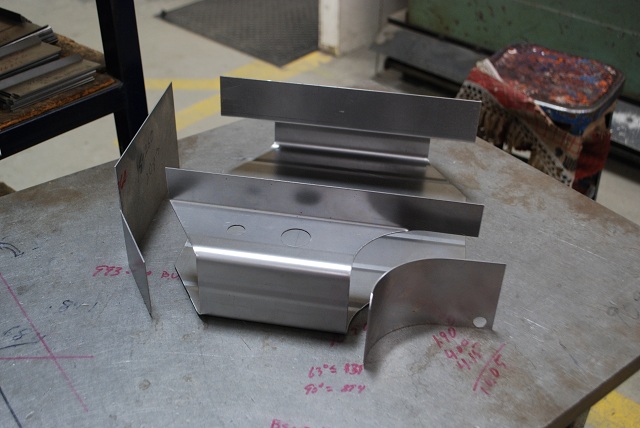 [9]
[9]Before being welded together, the sheet metal is bent. Here you can see how the strangely-shaped individual pieces of metal are pieced together, much like a puzzle.
“At this point, billet rails and baffling will also be added, and the oil pan will be test fitted to its corresponding block,” says Zeranski Jr. From tacking, they proceed to full-on welding. Canton TIG welds all of their oil pans, even steel ones, because it allows for greater control over the welds and lessens the likelihood of leaks. The pans will be checked over and over again for the quality of the welds, though from what we saw, they have nothing but professionals dedicated to their craft working the welders. If welding is an art, Canton has a staff full of Michelangelos and Picassos working for them. Again the pans will be fitted to ensure they haven’t lost their shape before moving on to finishing in the next room over.
Putting Each Pan to the Test
Yet again, the oil pan will be block checked by another individual and ground down to ensure there are no sharp edges anywhere on the pan. Bungs and the drain plug will be added at this point, and the part number will be stamped into the product before it is leak tested. This is after all an oil pan, and even the most minor leak could prove to be disastrous.
After a leak test is performed, it is outsourced to a local plating company for that iconic golden finish. “When the pan gets back, it is leak tested yet again. The plating process uses an acid bath, which could eat away at a weak weld. This way we make sure our customer is getting a quality product,” says Zeranski Jr.
Custom Applications, Watching Pan Weight and Why Gold? A Quick Q&A With Canton
It can be easy to take something as simple as an oil pan for granted. We often forget that there are people hard at work perfecting their products, testing them time and time again to ensure they work right. Still, knowing how an oil pan is built may not answer all of your questions.
powerTV: What can Canton do when a customer shows up with some weird conversion or hot rod you’ve never seen before?
Mike Zeranski Jr: “Since Canton has it’s roots in custom oil pan manufacturing, we’ve done custom versions of almost all our products over the years. Be it mild to wild, single one-off pans or larger production runs, we’re happy to take it on.”
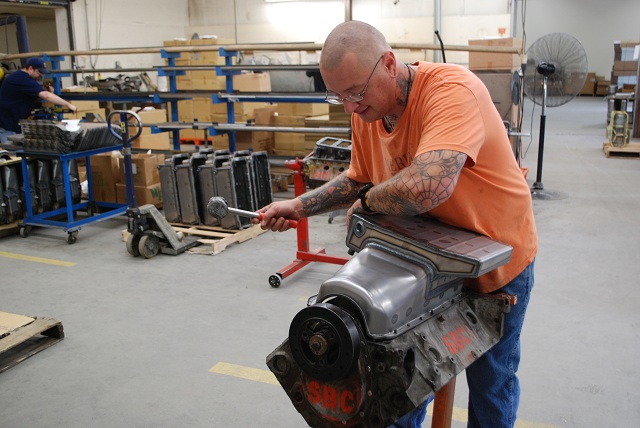 [11]
[11]Canton has dozens of different engine blocks on hand to ensure an exact fit. A large hammer helps too
PTV: Without test-fitting the pan before buying it, how can someone tell if a Canton pan is the right fit for their car?
Zeranski: “Our years of experience have given us a good idea which pans are best suited for most applications. Many of our oil pans are specifically designed for a particular chassis, but if we don’t list your chassis, we can usually make a pretty solid recommendation. Just take a tape measure to the engine bay and use the sump dimensions we give you to be certain it’ll fit.”
PTV: So, how much oil am I supposed to use with a Canton pan?
Zeranski: “Our oil pans are rated by their total system capacities, which includes the oil pan and the filter. These capacities are calculated on the pan’s sump size and designed to keep oil low and away from the rotating assembly. Of course, if a cooler, remote filter or another oil system accessory is present, the volume will have to be adjusted accordingly.”
PTV: Isn’t TIG welding more time-consuming and expensive?
Zeranski: “All of our oil pans are TIG welded by hand to ensure consistent welds on all seam and are leak tested at least twice during production. As a result the occurrence of leaks in our pans is very rare even after years of service. Although it is much more time-consuming than other forms of welding, TIG welding allows for more control, better penetration, and doesn’t have the cold starts typical of other forms of welding. Overall, it provides a better weld with less possibility for leaks and cracks. We think its worth it.”
PTV: How about windage trays? Do they even make that much of a difference?
Zeranski: “Windage trays are optional but recommended. Some of our pans come with a windage tray pre-installed and some have the option to add one. In either case, a windage tray works great to provide a few more easy horsepower by freeing up the rotating assembly from the drag created by oil mist. For the engine builder, they can provide that little extra that is needed to reach a goal horsepower on the dyno, which of course, is a big deal.”
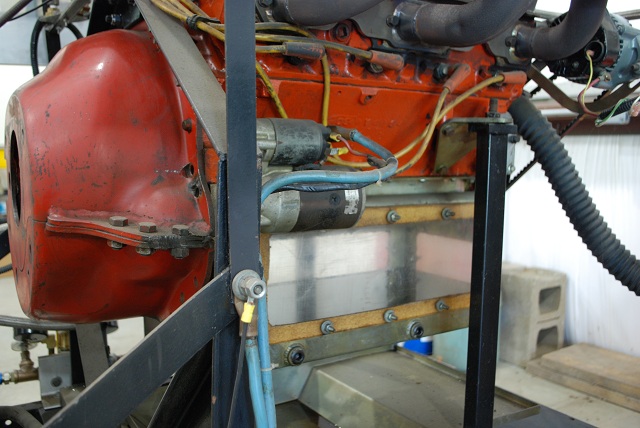 [13]
[13]Canton uses a special engine test stand with a see-through oil pan to research how oil flow is affected
PTV: How much research and testing can really go into making an oil pan?
Zeranski: “We’ve studied the motion of oil in the pan and within the crankcase and build our designs to increase oil control and reduce crankcase windage. We test these designs across a wide range of tracks and engine setups using a group of our own vehicles and by working closely with top engine builders and racers across the country. So, in essence, quite a bit.”
PTV: Besides the obvious weight difference, what’s the difference between your aluminum and steel pans?
Zeranski: “Our steel and aluminum pans are built with many of the same oil control and power features, but their manufacturing processes are quite different. Our steel pans are built from 16-gauge material and typically have stamped seals and pan rails. Our aluminum pans are built from .100 aluminum and use machined billet aluminum seals. The aluminum pans obviously have the advantage of being lighter then their steel counterparts.”
PTV: Sure gold is popular, but does Canton offer any different finishes?
Zeranski: “Most of our steel oil pans feature gold iridite plating for corrosion protection and in the case of our truck and marine pans, a black powder coated finish. We can also accommodate special requests to have any particular pan plated, powder coated, or left unfinished.”
 [14]
[14]Canton's finished oil pans mostly come in a gold anodized finish, but can be powdercoated to match a specific engine color as well.
PTV: What do you mean by oil control? How does an oil pan “control oil?”
Zeranski: “It’s basically controlling oil and keeping it directed to the oil pump pickup. To do this, we use baffling systems designed to work with the oil pan’s sump design. Our baffle systems use a combination of precisely positioned oil runners; one-way trap door baffles, crank scrapers, and slosh baffles. These features working together keep oil close to the pickup for scavenging and away from the rotating crank.”
Who knew so many simple devices could have such a profound effect on how our oil pans work? It just goes to show that even an oil pan can have a huge impact on the way we drive and race, and that we should never underestimate the difference even the seemingly simplest products can make. We’d like to thank Canton once again for taking us on a tour of their facilities. Special thanks to Mike Zeranski Jr. and Mike Bernardi for explaining the technical details and giving us a better idea of all the work that goes into one of the most understated parts on our engines.
